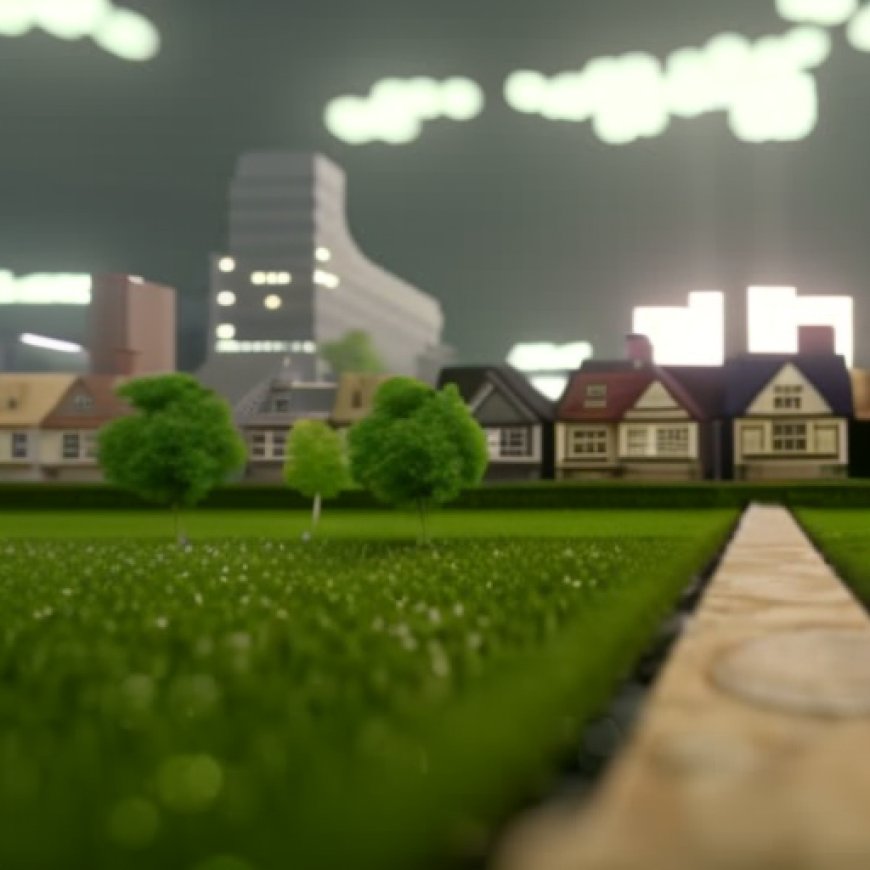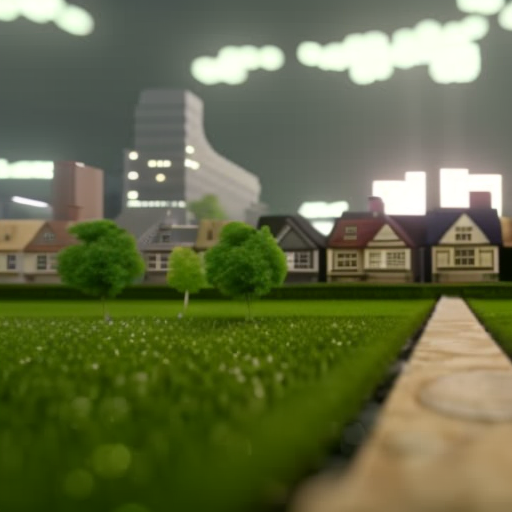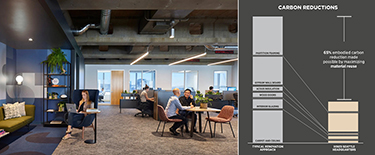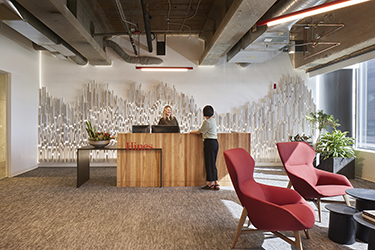Toward a path to zero carbon: building renovations and circular economy principles
Toward a path to zero carbon: building renovations and circular economy principles Seattle Daily Journal of Commerce


April 25, 2024
Toward a path to zero carbon: building renovations and circular economy principles
By JENN CHEN and JUSTIN SCHWARTZHOFF
LMN ARCHITECTS
The embodied carbon footprint of an interior renovation can be drastically reduced by taking ownership of what already exists in a space, repurposing materials rather than sending them to a landfill and seeking out unused stock.
How does the building industry align around radical, pragmatic decarbonization? Along with addressing climate pollution from energy use, we also must address the climate pollution that comes from manufacturing construction materials like concrete, steel, and even carpet and furniture. Known as embodied carbon, this pollution is around 20% of global greenhouse gases, and represents the next frontier in decarbonization. The solution toolkit includes building reuse and circular economy, sustainably-sourced mass timber, zero-carbon concrete and steel, structural materials efficiency, agricultural-waste biogenic materials and all-electric construction vehicles.
Since 2020, LMN Architects has led an industry-wide collaboration to uncover the challenges and consolidate solutions on carbon reduction through the Path To Zero Carbon series. With dozens of experts and peers involved, this provides the first comprehensive view of AEC carbon pollution and solutions.
CIRCULAR ECONOMY AS A KEY SOLUTION
Among solutions, transitioning to a circular economy is one of the most important. What is a circular economy? It means keeping materials, products and buildings in continual use instead of sending them to a landfill. From bricks and insulation to furniture and whole buildings, this means designing for timelessness, durability, and deconstruction, as well as salvaging from existing buildings, building a local refurbishment economy, and warehousing of refurbished products.
How does the circular economy impact carbon? In the case study below, buying best-in-class low carbon new products might have led to a 22% reduction in carbon, but by engaging the circular economy, the team realized a 65% embodied carbon reduction.

Chen

Schwartzhoff
Materials also can have stories that contribute to design; from the old brick and reclaimed wood character we love in coffee shops to materials like ceiling tiles and workstations that can be refurbished to be indistinguishable from new. Circular economy platforms and products like Rheaply, Reseat, Davies Furniture, and Doors Unhinged already exist nationally in some product categories, and local options exist in most cities.
RETHINKING RENOVATIONS
Office renovations are often excluded by embodied carbon measurements, ratings and ESG accounting. Major certifications systems, such as LEED, allow interiors material to be excluded from embodied carbon calculations (also referred to as Life Cycle Analysis or LCA). A lack of carbon data (Environmental Product Declarations or EPDs) for interiors materials makes tracking emissions more difficult even if an owner wants to include them.
This is a huge potential oversight, as an early LMN study on interior renovations suggested that interior renovations could make up the largest percentage of embodied carbon over 60 years, larger even than building envelope and structure. Renovations have accelerated as well, and often require a restoration clause that requires tenants to remove everything from their space when their lease is up, even if carpet, walls, ceilings and furniture have a decade or two of useful life remaining.
Office furniture alone is estimated to account for over 8.5 million tons of waste per year. Worse, most office furniture is designed to function for 10-15 years, but with the short refresh cycle of seven years or less, much of this furniture is being sent to the landfill with years of useful life remaining. And with offices downsizing to accommodate a shift to hybrid work, this volume of furniture waste will likely increase over the next few years.
Can we rethink renovations? Starting with what exists already in a building and space, can existing materials and layouts remain in place as part of a thoughtful, new design instead of being removed? Can we capture the economic and carbon value of used materials instead of landfilling them?
PATH TO ZERO-CARBON INTERIORS
SDGs, Targets, and Indicators Analysis
1. Which SDGs are addressed or connected to the issues highlighted in the article?
- SDG 7: Affordable and Clean Energy
- SDG 9: Industry, Innovation, and Infrastructure
- SDG 11: Sustainable Cities and Communities
- SDG 12: Responsible Consumption and Production
- SDG 13: Climate Action
The article discusses the need for decarbonization in the building industry, which aligns with SDG 7 (Affordable and Clean Energy) and SDG 13 (Climate Action). It also mentions the importance of transitioning to a circular economy, which is related to SDG 9 (Industry, Innovation, and Infrastructure) and SDG 12 (Responsible Consumption and Production). Additionally, the article highlights the impact of renovations on embodied carbon, which relates to SDG 11 (Sustainable Cities and Communities).
2. What specific targets under those SDGs can be identified based on the article’s content?
- SDG 7.2: Increase the share of renewable energy in the global energy mix.
- SDG 9.4: Upgrade infrastructure and retrofit industries to make them sustainable.
- SDG 11.4: Strengthen efforts to protect and safeguard the world’s cultural and natural heritage.
- SDG 12.2: Achieve sustainable management and efficient use of natural resources.
- SDG 13.2: Integrate climate change measures into national policies, strategies, and planning.
Based on the article’s content, the targets identified are related to increasing the share of renewable energy (SDG 7.2), upgrading infrastructure and retrofitting industries (SDG 9.4), protecting cultural and natural heritage (SDG 11.4), achieving sustainable resource management (SDG 12.2), and integrating climate change measures into policies (SDG 13.2).
3. Are there any indicators mentioned or implied in the article that can be used to measure progress towards the identified targets?
- Percentage of renewable energy in the global energy mix
- Number of infrastructure upgrades and retrofits for sustainability
- Number of cultural and natural heritage sites protected and safeguarded
- Resource efficiency in the construction industry
- Integration of climate change measures in building design and construction
The article does not explicitly mention specific indicators, but it implies that progress towards the identified targets can be measured by tracking the percentage of renewable energy in the global energy mix, the number of infrastructure upgrades and retrofits for sustainability, the number of cultural and natural heritage sites protected and safeguarded, resource efficiency in the construction industry, and the integration of climate change measures in building design and construction.
SDGs, Targets, and Indicators Table
| SDGs | Targets | Indicators |
|---|---|---|
| SDG 7: Affordable and Clean Energy | Increase the share of renewable energy in the global energy mix (7.2) | Percentage of renewable energy in the global energy mix |
| SDG 9: Industry, Innovation, and Infrastructure | Upgrade infrastructure and retrofit industries to make them sustainable (9.4) | Number of infrastructure upgrades and retrofits for sustainability |
| SDG 11: Sustainable Cities and Communities | Strengthen efforts to protect and safeguard the world’s cultural and natural heritage (11.4) | Number of cultural and natural heritage sites protected and safeguarded |
| SDG 12: Responsible Consumption and Production | Achieve sustainable management and efficient use of natural resources (12.2) | Resource efficiency in the construction industry |
| SDG 13: Climate Action | Integrate climate change measures into national policies, strategies, and planning (13.2) | Integration of climate change measures in building design and construction |
Behold! This splendid article springs forth from the wellspring of knowledge, shaped by a wondrous proprietary AI technology that delved into a vast ocean of data, illuminating the path towards the Sustainable Development Goals. Remember that all rights are reserved by SDG Investors LLC, empowering us to champion progress together.
Source: djc.com

Join us, as fellow seekers of change, on a transformative journey at https://sdgtalks.ai/welcome, where you can become a member and actively contribute to shaping a brighter future.









